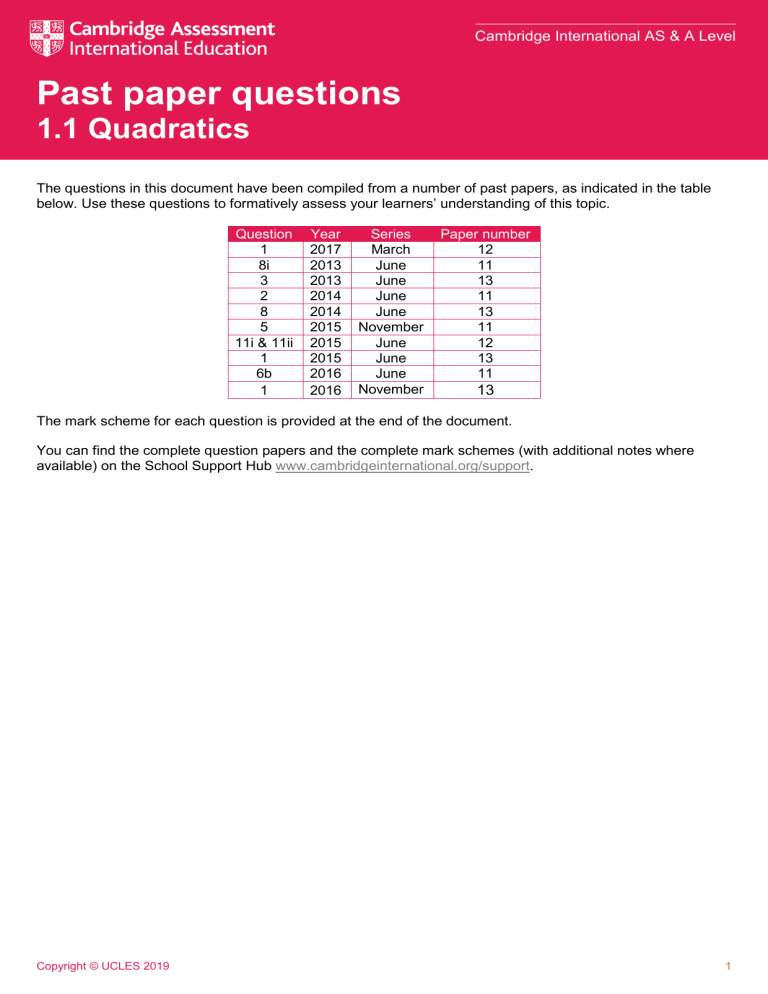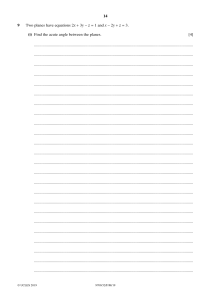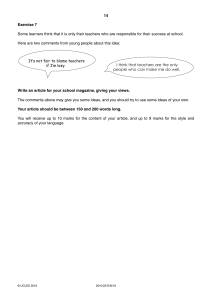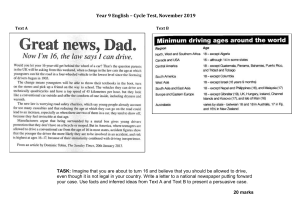
Cambridge International AS & A Level Past paper questions 1.1 Quadratics The questions in this document have been compiled from a number of past papers, as indicated in the table below. Use these questions to formatively assess your learners’ understanding of this topic. Question 1 8i 3 2 8 5 11i & 11ii 1 6b 1 Year 2017 2013 2013 2014 2014 2015 2015 2015 2016 2016 Series March June June June June November June June June November Paper number 12 11 13 11 13 11 12 13 11 13 The mark scheme for each question is provided at the end of the document. You can find the complete question papers and the complete mark schemes (with additional notes where available) on the School Support Hub www.cambridgeinternational.org/support. Copyright © UCLES 2019 1 Copyright © UCLES 2019 2 Copyright © UCLES 2019 3 Copyright © UCLES 2019 4 Copyright © UCLES 2019 5 Copyright © UCLES 2019 6 Copyright © UCLES 2019 7 Copyright © UCLES 2019 8 Copyright © UCLES 2019 9 Copyright © UCLES 2019 10 Copyright © UCLES 2019 11 Mark schemes Mark Scheme Notes Marks are of the following three types: M Method mark, awarded for a valid method applied to the problem. Method marks are not lost for numerical errors, algebraic slips or errors in units. However, it is not usually sufficient for a candidate just to indicate an intention of using some method or just to quote a formula; the formula or idea must be applied to the specific problem in hand, e.g. by substituting the relevant quantities into the formula. Correct application of a formula without the formula being quoted obviously earns the M mark and in some cases an M mark can be implied from a correct answer. A Accuracy mark, awarded for a correct answer or intermediate step correctly obtained. Accuracy marks cannot be given unless the associated method mark is earned (or implied). B Mark for a correct result or statement independent of method marks. • When a part of a question has two or more “method” steps, the M marks are generally independent unless the scheme specifically says otherwise; and similarly when there are several B marks allocated. The notation DM or DB (or dep*) is used to indicate that a particular M or B mark is dependent on an earlier M or B (asterisked) mark in the scheme. When two or more steps are run together by the candidate, the earlier marks are implied and full credit is given. • The symbol or FT implies that the A or B mark indicated is allowed for work correctly following on from previously incorrect results. Otherwise, A or B marks are given for correct work only. A and B marks are not given for fortuitously “correct” answers or results obtained from incorrect working. • Note: B2 or A2 means that the candidate can earn 2 or 0. B2/1/0 means that the candidate can earn anything from 0 to 2. The marks indicated in the scheme may not be subdivided. If there is genuine doubt whether a candidate has earned a mark, allow the candidate the benefit of the doubt. Unless otherwise indicated, marks once gained cannot subsequently be lost, e.g. wrong working following a correct form of answer is ignored. • Wrong or missing units in an answer should not lead to the loss of a mark unless the scheme specifically indicates otherwise. • For a numerical answer, allow the A or B mark if a value is obtained which is correct to 3 s.f., or which would be correct to 3 s.f. if rounded (1 d.p. in the case of an angle). As stated above, an A or B mark is not given if a correct numerical answer arises fortuitously from incorrect working. For Mechanics questions, allow A or B marks for correct answers which arise from taking g equal to 9.8 or 9.81 instead of 10. The following abbreviations may be used in a mark scheme or used on the scripts: AEF/OE Any Equivalent Form (of answer is equally acceptable) / Or equivalent AG Answer Given on the question paper (so extra checking is needed to ensure that the detailed working leading to the result is valid) BOD Benefit of Doubt (allowed when the validity of a solution may not be absolutely clear) CAO Correct Answer Only (emphasising that no “follow through” from a previous error is allowed) CWO Correct Working Only – often written by a ‘fortuitous’ answer ISW Ignore Subsequent Working MR Misread PA Premature Approximation (resulting in basically correct work that is insufficiently accurate) SOI Seen or implied SOS See Other Solution (the candidate makes a better attempt at the same question) SR Special Ruling (detailing the mark to be given for a specific wrong solution, or a case where some standard marking practice is to be varied in the light of a particular circumstance) Penalties MR –1 A penalty of MR –1 is deducted from A or B marks when the data of a question or part question are genuinely misread and the object and difficulty of the question remain unaltered. In this case all A and B marks then become “follow through ” marks. MR is not applied when the candidate misreads his own figures – this is regarded as an error in accuracy. An MR –2 penalty may be applied in particular cases if agreed at the coordination meeting. PA –1 This is deducted from A or B marks in the case of premature approximation. The PA –1 penalty is usually discussed at the meeting. Copyright © UCLES 2019 13 May/June 2017 Paper 12 May/June 2013 Paper 11 May/June 2013 Paper 13 May/June 2014 Paper 11 Copyright © UCLES 2019 14 May/June 2014 Paper 13 November 2015 Paper 11 May/June 2015 Paper 12 Copyright © UCLES 2019 15 May/June 2015 Paper 13 May/June 2016 Paper 11 November 2016 Paper 13 Copyright © UCLES 2019 16








